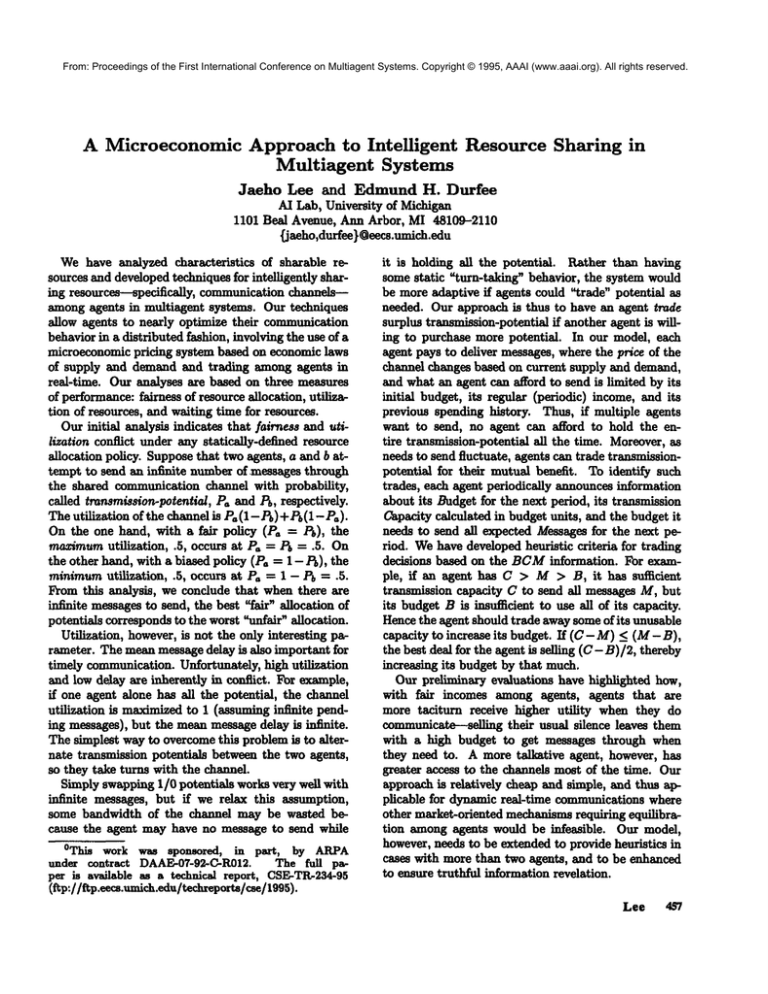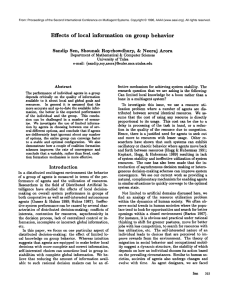
From: Proceedings of the First International Conference on Multiagent Systems. Copyright © 1995, AAAI (www.aaai.org). All rights reserved.
A Microeconomic Approach to Intelligent
Resource Sharing in
Multiagent Systems
Jaeho Lee and EdmundH. Durfee
AI Lab, University of Michigan
1101 Beal Avenue, Ann Arbor, MI 48109-2110
(jaeho,durfee)Qeecs.umich.edu
Wehave analyzed characteristics
of sharable resources and developed techniques for intelligently sharing resources--specifically,
communication channels-among agents in multiagent systems. Our techniques
allow agents to nearly optimize their communication
behavior in a distributed fashion, involving the use of a
microeconomic pricing system based on economic laws
of supply and demand and trading among agents in
real-time. Our ~alyses are based on three measures
of performance: fairness of resource allocation, utilization of resources, and waiting time for resources.
Our initial analysis indicates that fairness and utilization conflict under any statically-defined resource
allocation policy. Suppose that two agents, a and b attempt to send an infinite number of messages through
the shared communication channel with probability,
called transmission-potential, P, and Pb, respectively.
The utilization of the channel is P.(1-Pb) +Pb(1--P~).
On the one hand, with a fair policy (P~ - Pb), the
mazimumutilization, .5, occurs at P~ -- Pb -- .5. On
the other hand, with a biased policy (Pa -- 1 -Pb), the
minimumutilization,
.5, occurs at Pa = 1 - Pb -- .5.
From this analysis, we conclude that when there are
infinite messagesto send, the best "fair" allocation of
potentials corresponds to the worst "unfair" allocation.
Utilization, however, is not the only interesting parameter. The mean message delay is also important for
timely communication. Unfortunately, high utilization
and low delay are inherently in conflict. For example,
if one agent alone has all the potential, the channel
utilization is maximized to 1 (assuming iv6nite pending messages), but the mean message delay is infinite.
The simplest way to overcome this problem is to alternate transmission potentials between the two agents,
so they take turns with the cllannel.
Simply swapping 1/0 potentials works very well with
infinite messages, but if we relax this assumption,
some bandwidth of the channel may be wasted because the agent may have no message to send while
°This work was sponsored,
in part, by ARPA
under contract DAAE-07-92-C-R012.
The full paper is available as a technical report, CSE-TR-234-95
(ftp://ftp.eecs.umich.edu/tech~ports/cse/1995).
it is holding all the potential. Rather than having
some static "turn-taking" behavior, the system would
be more adaptive if agents could "trade" potential as
needed. Our approach is thus to have an agent trade
surplus transmission-potential if another agent is willing to purchase more potential. In our model, each
agent pays to deliver messages, where the pr/ce of the
channelchanges basedon currentsupplyand demand,
andwhatan agentcanaffordto sendis limited
by its
initial
budget,
itsregular
(periodic)
income,
andits
previous
spending
history.
Thus,if multiple
agents
wantto send,no agentcan affordto holdthe entiretransmission-potential
allthetime.Moreover,
as
needs to send fluctuate, agents can trade transmissionpotential for their mutual benefit. To identify such
trades, each agent periodically announces information
about its Budget for the next period, its transmission
Capacity calculated in budget units, and the budget it
needs to send all expected Messages for the next period. Wehave developed heuristic criteria for trading
decisions based on the BCMinformation. For example, if an agent has C ~ M) B, it has sufficient
transmission capacity C to send all messages M, but
its budget B is insufficient to use all of its capacity.
Hence the agent should trade away some of its unusable
capacity to increase its budget. If (C- M) < (M- B),
the best deal for the agent is selling (C-B)/2, thereby
increasing its budget by that much.
Our preliminary evaluations have highlighted how,
with fair incomes among agents, agents that are
more taciturn receive higher utility
when they do
communicate--selling their usual silence leaves them
with a high budget to get messages through when
they need to. A more talkative agent, however, has
greater access to the channels most of the time. Our
approach is relatively cheap and simple, and thus appficable for dynamic real-time communications where
other market-oriented mechanismsrequiring equilibration among agents would be infeasible.
Our model,
however, needs to be extended to provide heuristics in
cases with more than two agents, and to be enhanced
to ensure truthful information revelation.
Lee
4~






